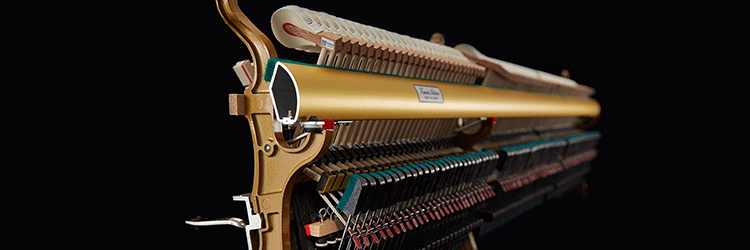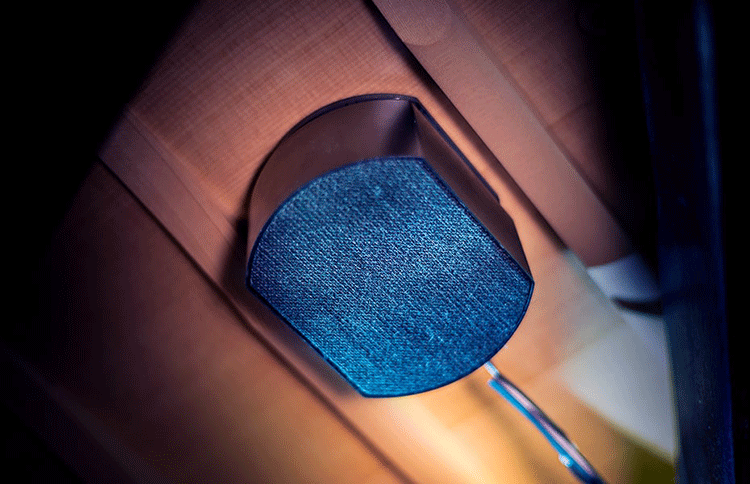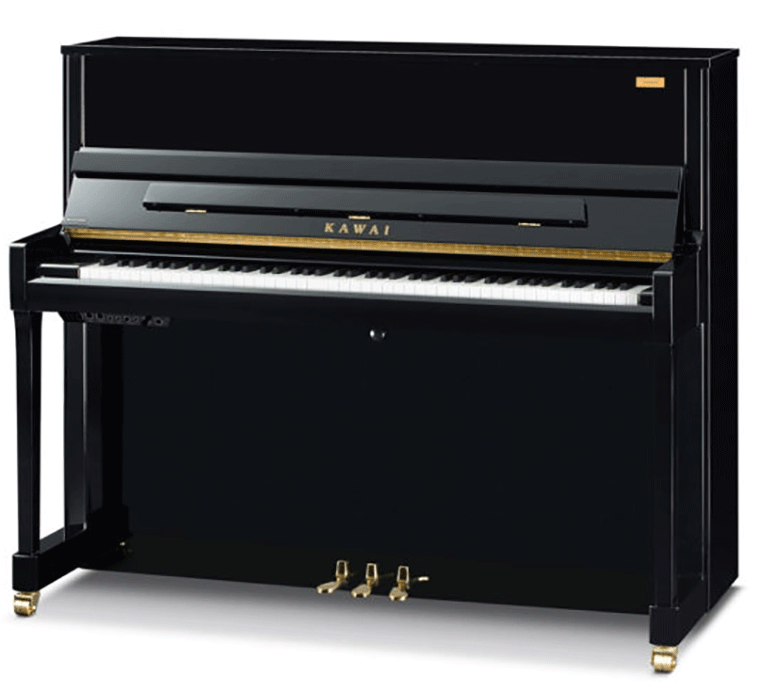Kawai K300 Aures | Overview
The Kawai K300 Aures Hybrid Upright piano has been an absolute sensation since it hit the market. It is a hybrid piano meaning this is a mix of both digital and acoustic technology. Sometimes manufacturers use the term hybrid instrument very liberally, but in this case, the K-300 Aures is a true hybrid piano in every sense of the word.
It’s a full Kawai K-300 acoustic piano augmented by the guts of a CA99 Kawai digital piano with four transducers directly connected to the soundboard as well as a 256-note polyphony piano sound engine that contains the SK-EX Rendering sound source as well as a host of other instruments, all controllable via an easy to use touchscreen display.
For folks looking for a true upright piano experience with all of the advantages of a digital piano, including being able to play with headphones, the K-300 Aures checks all the boxes.
Let’s start by taking a look at the acoustic upright action.
Kawai K300 Aures | Piano Keys and Piano Action
Millennium III Abs-Carbon Upright Action

As a K300 professional upright piano, the Aures is outfitted with the Millennium III Abs-Carbon Upright Action. The Millennium III Action represents a number of key innovations that have led to widespread acclaim for the actions, both in terms of design and actual performance.
Extended Key Length
One key feature is the extended key-stick length, which provides the player with a greater level of control.
The other advantage of the longer key stick is it increases the potential torque or force that the player can apply to the capstan. This means there’s an increased dynamic range with which you’re given to work.
Double-felted Mahogany Core Hammers Key Texture
There’s also a nice texture on the keys, but not the upgraded NEOTEX material – you have to jump to the larger K-500 Aures for that – one of the finest hybrid uprights out there.
Along with the action on the Millennium III, you’re getting double-felted mahogany core hammers. Mahogany is a lighter material for hammer cores, which means that the hammer stays on the string less, which equates to less potential distortion.
In order to silence the action or prevent the hammer from hitting the string when in digital mode there needs to be a silencing bar that basically gets in the way.
Sometimes what happens with these silencing systems is you wind up having to regulate the action based on where the silent bar is. It then works nicely in silent mode, but when you switch back to regular acoustic mode, the action feels totally off.
Additional Acoustic Piano Action
On the K300 Aures, you have virtually perfect regulation in both acoustic mode as well as digital mode, with no difference in control and repetition speed.
This may seem like a small thing, but it’s actually a huge deal. The fact that Kawai has solved this issue means this type of instrument is suddenly opened up to a huge portion of the market that would have previously not been interested in settling for something with uneven regulation.
And for some people, they need the touch of an acoustic piano, but for a variety of reasons, the volume of an acoustic instrument is just too much for where they live. Being able to flip a switch and plug in a set of headphones while still enjoying a great acoustic action is tough to put a price on.
It’s no real surprise that the K300 has been such a darling of the institutional world because this has made it an ideal practice instrument for advanced instrumentalists. Because this is an Aures version though, there are some modifications to the action which need to be pointed out.
This will probably be the beginning of a very strong trend in the industry toward instruments that can accommodate that type of sound management with the Kawai Aures series leading the way.
Let’s move on to the sound and some design-related features.
K300 Soundboard and Sound Sources

As a K300, there are a lot of really good things to talk about with this instrument right off the bat when it comes to tone. One of them is the scale design that has been implemented on this instrument, as you get a longer than average bass string resulting in more bass presence and clarity compared to other 48″ uprights.
The Kawai K-300 Aures also has 5 very solid back posts, meaning this is a well-built instrument that’s made to stand up even in institutional settings.
Tapered Solid Spruce
One of the most clearly notable features of the sound-producing parts of this instrument s of course the tapered solid spruce soundboard. Pretty much all great pianos have a tapered soundboard, but not that many are available at this price point.
The tapered soundboard makes this piano very responsive and very dynamic. You can get quite quiet but the whole horsepower of this piano really leaps up and gives you a lot of really cool tonal palettes to work with as a player.
Kawai usually tends to be considered a little darker and a little more colorful as compared to something like a Yamaha U1, and this is largely due to the mahogany hammers, as well as the fact that Kawai actively voices their hammers to be darker.
High-end Performance Transducers powered by Onkyo Transducers
When we get into the digital sound engine aspects of the Aures, this is what tends to blow people away. When the digital sound technology is engaged, the main portion of the sound
is actually coming from the soundboard itself via multiple Onkyo transducers.
These performance transducers are acting as magnets that essentially turn the soundboard into one giant electronic speaker, but it’s using the natural spruce to give it a very distinctive tone.
Additional Piano Sounds
The closest thing to this on another piano musical instrument is what Kawai has been doing with their Concert Artist digital pianos – the CA99, CA98, and CA97 where you have a transducer on a small soundboard. We’ve never seen anything that’s tackled it at this level with this amount of success.
The bass response that you get out of using a transducing surface like a soundboard is just crazy.
You can activate the sound engine at any time, and actually layer a digital sound with the acoustic sound of the instrument, such as adding strings to the piano sound.
Special Features
SK-EX Rendering with Multi-Channel Sampling

In fact, you’re given access to the entire SK-EX Concert Grand sample set with multi-channel sampling and Resonance modeling, so if you’d prefer the concert grand piano to start coming through, simply select it on the LCD touchscreen. The sound coming through the soundboard is super lush, with things like cabinet resonance, ambiance, and string resonance really coming through.
Harmonic Imaging XL Sound Mode
You’re also given the Harmonic Imaging XL engine with 256-note polyphony for a variety of other sounds as well.
There are a killer Rhodes electric piano sound on it, quite a few pipe organs, and some really nice strings patches as well.
Integrated Bluetooth MIDI and Audio Wireless Technology
All of the other typical high-end digital features are here too, such as Bluetooth MIDI and Bluetooth Audio, which is super cool as this will allow you to stream music directly through the piano’s soundboard for an unbeatable audio experience.
You can also record WAV and SMF files to USB.
Lesson Books
There’s also a bunch of preloaded lesson books and finger exercises from Alfred, Czerny, and Beyer, and an assortment of recordings of great classical works from composers like Bach and Chopin.
Wrap Up

The K300 Aures is one of the most interesting innovative piano products on the market today. You’ve got the great Millennium III upright action, the entire Shigeru Kawai sample set, the ability to play acoustically or with headphones, and all of the other benefits of a digital piano.
If you can get to a showroom somewhere close to where you live to try this cool Kawai hybrid out, even if you aren’t in the market for a new instrument, you won’t be disappointed.
Thanks for reading! Don’t forget to visit Merriam Music for more articles and watch more piano review covers on our Youtube channel.

